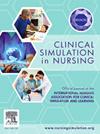临床判断、以人为本的护理和专业精神:对虚拟病人模拟中学生表现的跨模式有序网络分析
IF 3.4
3区 医学
Q1 NURSING
引用次数: 0
摘要
背景很少有研究将护生在模拟中的表现与《要点》和 NCJMM 中规定的临床能力联系起来。这项回顾性研究考察了基于屏幕的虚拟病人模拟(VPS)在促进 10 名本科执照前学生实践临床判断、以人为本的护理和专业精神方面的有效性。方法使用跨模态有序网络分析(T/ONA)分析了老年学和心理健康情景中病人互动、检查操作和记录的多模态记录。我们考察了学生在识别线索、分析线索、诊断和确定假设的优先次序、产生解决方案、评估结果、主观评估、治疗沟通以及护理管理和协调等方面建立联系的强度和顺序。然而,对于提出姑息治疗需求的虚拟病人和提出精神健康护理需求的虚拟病人,学生的联系模式有明显不同。T/ONA为研究学生在模拟中的行为提供了一种新颖而系统的方法。本文章由计算机程序翻译,如有差异,请以英文原文为准。
Clinical judgment, person-centered care and professionalism: A transmodal ordered network analysis of student performance in virtual patient simulations
Background
Few studies have connected nursing students’ performance in simulations to clinical competencies exemplified in The Essentials and the NCJMM. This retrospective study examined the effectiveness of screen-based virtual patient simulations (VPS) in facilitating ten undergraduate prelicensure students’ practice of clinical judgment, person-centered care, and professionalism.
Methods
Multimodal transcripts capturing patient interactions, exam actions, and documentation in a gerontology and mental health scenario were analyzed using Transmodal Ordered Network Analysis (T/ONA). We examined the strength and order of connections students made to recognizing cues, analyzing cues, diagnosing and prioritizing hypotheses, generating solutions, evaluating outcomes, subjective assessment, therapeutic communication, and care-management and coordination.
Findings
Both scenarios afforded opportunities for students to gather comprehensive data and make evidence-based and patient-centered care decisions. However, students’ patterns of connection making were significantly different for virtual patients who presented palliative care versus mental health care needs.
Conclusion
The assurance for nursing students’ practice readiness can be realized through careful implementation of diverse assignment types and scenarios in VPS. T/ONA provides a novel and systematic approach for studying student behaviors in simulations.
求助全文
通过发布文献求助,成功后即可免费获取论文全文。
去求助
来源期刊

Clinical Simulation in Nursing
NURSING-
CiteScore
5.50
自引率
15.40%
发文量
107
期刊介绍:
Clinical Simulation in Nursing is an international, peer reviewed journal published online monthly. Clinical Simulation in Nursing is the official journal of the International Nursing Association for Clinical Simulation & Learning (INACSL) and reflects its mission to advance the science of healthcare simulation.
We will review and accept articles from other health provider disciplines, if they are determined to be of interest to our readership. The journal accepts manuscripts meeting one or more of the following criteria:
Research articles and literature reviews (e.g. systematic, scoping, umbrella, integrative, etc.) about simulation
Innovative teaching/learning strategies using simulation
Articles updating guidelines, regulations, and legislative policies that impact simulation
Leadership for simulation
Simulation operations
Clinical and academic uses of simulation.
 求助内容:
求助内容: 应助结果提醒方式:
应助结果提醒方式:


